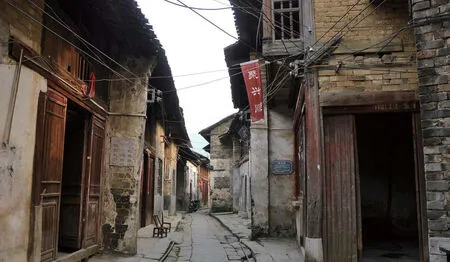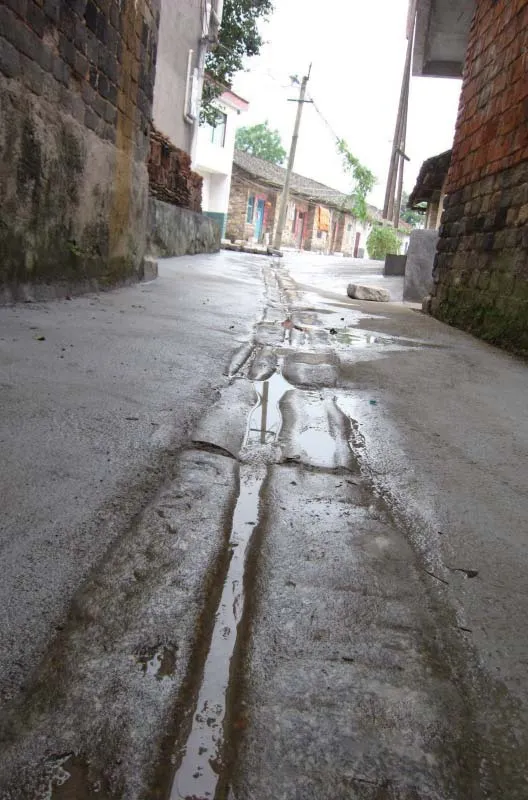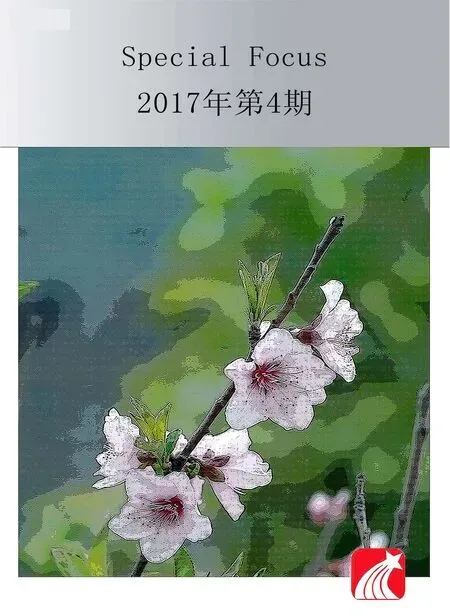第二章:千年茶都羊楼洞
2017-07-03
第二章:千年茶都羊楼洞
Chapter 2:er 2: Yangloudong, ong, the Tea Capital of Ancient China
万嶂入羊楼,双溪绕凤丘。
天开珠洞晓,月旁石潭秋。
翠入梧桐秀,香来蕙草幽。
登临一长啸,日夕紫烟浮。
A thousand peaks join at Yanglou, a pair of brooks round Phoenix Hill.
The sky opens at dawn like pearl, the moon lies next to the tea trader’s ville.
Jade joins the radiance of the phoenix tree, swaying above the holy basil’s serenity.
I ascend the butte when the wind’s howl rings out from behind the trees,
And breaks the silence of the purple haze floating in the sunset breeze.
早在100多年前,地图上湖北最为知名的两个地方,其一为汉口,其二是羊楼洞。在《大清皇舆全图》上,羊楼洞的标记与汉口、武昌是一样的规格。
在中国茶业发展史上,羊楼洞扮演着重要角色,是著名的砖茶之乡。

As early as 100 years ago, Hankou and Yangloudong were the two most famous places on the map of Hubei. The Great Qing Empire Territory Map once specified Yangloudong as being of equal importance to Hankou and Wuchang.
Yangloudong has played an important role in the history of the Chinese tea industry. It is especially famous for the production of brick tea.



羊楼洞位于湖北省赤壁市区西南26公里的羊楼洞镇,是湘鄂两省交界之要冲,历史上是战略要地,也是商贾云集的地方,素有“小汉口”之称。
相传,有一对相爱的青年男女,逃婚到松峰山下,他们的白马化作羊,山羊排泄的粪便变成茶籽,长出漫山茶树。夫妇俩在山下搭起竹楼,楼上住人,楼下养羊。从此,人们称这里为羊楼洞。动人的传说寄托着当地人们对美好生活的向往。
作为万里茶道的源头之一,自唐太和年间(827年-835年)皇诏普种山茶起,羊楼洞就开始培植、加工茶叶。也是自那时起,羊楼洞黑茶加入国家茶马交易,通过大唐安西都护府翠叶城(今吉尔吉斯斯坦境内)销往西亚和欧洲。
赤壁地处幕阜山脉和江汉平原接壤的丘陵地带,雨水充足,日照时间长,土地肥沃。得天独厚的茶叶生长环境,使得该地所产茶叶极具特色,不仅味道纯正,且兼具药性。在古代医疗条件不太完善的时候,更是当地百姓出门随身携带的必备品。
老天非常青睐这个美丽的地方。除了优越的地理环境,境内东南松峰山下,还有三股天然泉水,名为观音泉。传说观音曾在松峰山上埋瓶流泉,淙淙泉水顺山而下,从镇中穿流而过。观音泉水质清澈甘醇,是历代精制名茶的水源。用这三股泉水炼制出来的茶,成就了味道独特、让人回味无穷的羊楼洞茶。
Yangloudong is located in the Yangloudong Township, 26 kilometers away from the southwest of the city of Chibi in Hubei Province. It is also an important border hub for both Hunan and Hubei; it was once of strategic positioning in history, especially for business, and has always been teeming with merchants, which earned it the nickname of “Little Hankou.”
Local legend has it that a young man and woman fell in love with each other. As their marriage was severely opposed by both families, the couple ran away and lived in seclusion at the foot of Mount Songfeng. Their horses magically turned into mountain goats whose manure contained tea tree seeds. The tea trees grew well and tall, blooming all over the mountain. Therefore, the couple built a cottage out of bamboo and lived upstairs, while the goats were kept downstairs. The place was called Yangloudong, meaning the “goat building.” This moving tale naturally embodied the locals’ hope for a better life.
During the Taihe Period in the Tang Dynasty (827-835), an imperial decree of popularizing tea had been released. Ever since then, tea has been planted widely and processed in the Yangloudong area, one of the starting points for the Tea Road. At the same time, the city’s black tea was listed into the national Tea-Horse Road trade, which guaranteed the sale of tea to West Asia and Europe across Cuiye City (today’s Kyrgyzstan).
Chibi is located in a hilly area adjacent to Mufu Mountain and Jianghan Plain where there is fertile land with ample rainfall and long sunshine duration. The tea produced here is of a singular variety, which not only boasts a pure, full-bodied flavor, but also medicinal properties owing to the favorable growing conditions. During the ancient times when medical care was less than optimal, medicinal teas were a daily necessity when the locals went out for travel.
God has munificently bestowed his grace and favor upon this resplendent land. Apart from the all-around superior geographical conditions, three natural springs named the Guanyin Springs flooded up at the foot of Mount Songfeng in the southeast. Legend has it that Goddess Guanyin buried a bottle of spring water in Mount Songfeng, so water trickles from the spring and runs down through the mountain, and directly to the town. This sweet, unadulterated water has been used for making premium tea since the ancient times. Yangloudong tea brewed from these three springs has a unique flavor with a pleasant aftertaste.


为了出远门携带方便和延长存贮时间,人们将茶叶制作成块状砖茶。宋代,人们曾一度以砖茶作为通货与内蒙进行茶马交易。“一斤易一羊,十斤易一牛,”可见砖茶在当时的珍贵与身价。
在所有的砖茶种类中,“川字号”砖茶是羊楼洞的专利。当年,羊楼洞人用观音泉制成的青砖茶深受蒙族人民钟爱。羊楼洞人在茶砖上凸印“川”字,寓意为观音泉的三股泉水,彰显观音泉之功。这里曾建有数十个茶叶加工厂,出现过“长盛川”、“巨盛川”、“三玉川”等数个“川”字号茶。
作为万里茶道上最被信任、销路最好的一种品牌,“川”字茶逐渐被蒙古、西北、直至万里之外的俄国所认可。“川”可以称之为茶道上的“第一国际品牌”,以至后来,心急的俄国人不远万里来到羊楼洞开办茶厂。
For convenience of transportation and longer storage time, the locals compressed dried tea leaves into tea bricks. In the Song Dynasty, this kind of brick tea was once adopted as a currency, used in exchange for animals between Mongolia and China. “One pound of brick tea for one sheep, ten pounds of brick tea for one cow.”Obviously, this old saying indicates the tremendous value of brick tea.
川 (chuān), the Chinese character standing for “river” was pressed into the brick tea, acting as a logo and patent for this time-honored brand of Yangloudong brick tea. The variety from the Guanyin Springs is particularly adored in Mongolia. To the Yangloudong locals, the three lines pressed into the top of the tea brick signifies the three streams that gush from the Guanying Springs, highlighting the springs’ importance. There were dozens of tea producing factories, including the brands of Changsheng Chuan, Jusheng Chuan, Sanyu Chuan, which all carry the same chuan character.
As the best-selling and most trusted brand on the Tea Road, the“chuan” brand of brick tea was gradually received by Mongolia, Northwest China and even Russia. It can be called the “first international brand.” Because of this, the Russians rushed to Yangloudong area to run tea-processing plants.

羊楼洞茶究竟何时走上万里茶道?目前比较流行的说法是:太平天国时期,茶源地被迫转移,导致晋商纷纷来到羊楼洞一带采办茶叶,促进当地茶叶资源的开发和利用,对羊楼洞茶区的形成和发展起到极大推动作用。
明嘉靖初时,本地制茶业已相当发达,集镇随之而兴。到了明清两代,中国边境城市恰克图(今俄罗斯境内)成为羊楼洞砖茶边贸重镇,洞茶飘香万里大草原。
《明史》记载,嘉靖元年(1522年)就有砖茶及松峰茶大量销往海外。当时沿海倭寇作乱,嘉靖皇帝封闭宁波、泉州港,留下来官方唯一许可港口广州。空前热闹的广州,聚集了从世界各地来中国淘金的商人们,最早在海上进行贸易的海外商人,在这一年采购了来自羊楼洞的松峰绿茶、砖茶40万斤……
清道光年间(1821年-1851年),有英、德、日、俄等国商人竞相在羊楼洞办厂制茶,国内晋、津、沪茶商亦蜂拥而至,其时有茶庄200余家,主要出产青砖茶、米砖茶等,年出口价值白银一千五百多万两。这片面积不足0.7平方公里的土地,汇集多国精英商贾,行成一个人口逾四万的“中国大茶市”,誉称“小汉口”。

When did Yangloudong become a place for exporting tea? Conventional wisdom says it was when Shanxi merchants flocked to Yangloudong to purchase tea during the Taiping Rebellion (1850-1864). Due to the fact that the source of tea production had to be relocated because of war, merchants came to Yangloudong in unending streams with one thought in mind—the acquisition and procurement of tea—which hastened the development and utilization of tea resources in Yangloudong, thus providing a massive boost to Yangloudong’s image and development as a top tea producer.
At the beginning of Emperor Jiajing’s reign (1522-1566) during the Ming Dynasty, the tea industry was well developed, with many small townships finding prosperity right along with it. In the Ming and Qing Dynasties, the Chinese border city of Kyakhta (Now Russian territory) became an important hub for trading on the frontier. And the sweet fragrance of Yangloudong tea was already wafting over the vast plains in the area.
According to the History of Ming, many brick teas and Songfeng teas were sold overseas in the year of 1522. Emperor Jiajing allowed the Canton port to stay open even after the closure of Ningbo and Quanzhou ports due to the pirates on coastal regions at that time. There were lots of merchants eager to cash in who clustered at busy Canton, and as a result, 400,000 pounds of Songfeng green tea and brick tea from Yangloudong were purchased by foreign merchants that year.
During Emperor Daoguang’s reign (1821 to 1851) in the Qing Dynasty, merchants from England, Germany, Japan, Russia and other countries competed in running tea factories at Yangloudong, as well as tea traders from Shanxi, Tianjin and Shanghai, swarming in droves. There were more than 200 tea factories during that time, mainly producing green and black brick teas, whose annual exports totaled more than 15 million silver taels. The elite from the four corners of the earth were crammed into an area of less than 0.7 square kilometers, making it a large tea market in China with a population of over 40,000, and earning it the nickname “Little Hankou.”

▲运茶用的独轮车 One-wheeled handcart used for transporting tea
这座古镇,曾经串连起一条繁荣百年的中俄茶叶之路,现在却面临被遗忘的尴尬。
松峰山的羊楼洞镇口,近年立了一块巨石,上面醒目地写着“欧亚万里茶道源头”几个红色大字,旁边刻有以羊楼洞为起点直至欧亚的茶道线路图。一条宽4米、长2200米的明清古街,正从这里蜿蜒地向镇深处延伸而去。这条街可称为中国制茶业发展的历史缩影。
清末政府修筑京汉铁路,原本线路设计要经过羊楼洞,但由于羊楼洞的乡绅们怕会坏了当地风水,执意不肯借道。于是,铁路改线经赵李桥镇南下。
铁路通车后,身处大山里的羊楼洞人,依然用独轮“鸡公车”这种原始的运输方式运进茶叶、送出茶砖。如今古街上还能看见寸余深槽,据说是历代运送茶叶的“鸡公车”碾压而成。这些历史遗留下的印迹,仿佛一册尘封古书在默默诉说古镇过往。
可以想象,那些年,每年几十万担茶砖,由那些当地或来自江西的精壮农民,用吱呀作响的独轮车,日夜不停地运往三十里外的新店,再运往汉口,运往包头和张家口,直至遥远的俄罗斯,那是怎样繁忙的情景。
在铁路未修前,河运是交通运输主要动脉。许多当年的商埠重镇由于交通运输方式的改变而沉寂,羊楼洞便是如此。
考虑到交通不便,上世纪五十年代,政府决定将羊楼洞茶厂迁至几里路外交通便捷的赵李桥镇,羊楼洞由此繁华落尽,渐渐沉寂。古街上还保存着明清时期的老屋500余栋,倔强地见证着古镇昔日的繁华。在保存较为完好的老宅院里,窗棱上精美的木雕,向我们诉说着羊楼洞人辛勤劳作之余,在建筑上蕴含的智慧和对美的追求。如今,这条古街少了繁忙,多了静谧。
羊楼洞的兴衰史就是一部茶叶的传奇史。虽然羊楼洞繁华的茶市一去不复返,但只要一提起“砖茶”,羊楼洞仍会被首先想起。值得庆幸的是,还有几家老字号坚守在羊楼洞,一直传承着这项古老的事业。
青山叠翠,茶园飘香,羊楼洞就这样淹没在历史,尘封于岁月。但是羊楼洞明清石板街还在,万里茶道的源流还在,远在万里的欧洲还喜欢“川”字牌青砖茶,还知道昔日号称“小汉口”的羊楼洞。
This ancient town, once linked to more than a century’s worth of Sino-Russo Tea Road, prosperity has now been virtually forgotten.
Now a megalith sits at the entrance of Yangloudong Town at Mount Songfeng. On it are written some Chinese characters in a deep crimson color, “The starting point of the Tea Road.” Beside it is engraved a map of the Tea Road marking the city as the starting point. From here, there is an ancient street decorated in the Ming and Qing style, 4 meters in width, and 2,200 meters in length, zigzaging its way towards the outside world. This street was a microcosm of all development of the Chinese tea industry.
Originally, the Peking-Hankow Railway, or Jinghan Railway, built in the late Qing Dynasty, was designed to cross Yangloudong. However, the locals were afraid that the construction of the railway would ruin the Feng Shui of the area, so they were strongly opposed to the railway construction plan. The railway was forced to alter its route and cross the nearby town of Zhao Liqiao instead.
After the railway was put into use, the local people of Yangloudong continued using wheelbarrows to transport tea. Even today, you can still see inch-deep grooves that were worn into the ancient street, which was allegedly caused by the constant wheeling back and forth of the “one-wheeled handcarts” used as the primary means of transporting tea for shipping. This ancient marking is like a dusty old book serving as historical records of the town’s past history.
You can imagine the spectacular scene featuring hundreds of thousands of squeaky old wheelbarrows loaded down with brick tea being transported day and night by the hands of strong and hunkish young farmers, local or from Jiangxi, to Xindian Town miles away. From there, the tea bricks were transported to Baotou and Zhang Jiakou through Hankou, and finally to the far-off Russian cities.
Before the construction of the railway, river transportation was the most important and reliable means of shipping and many once flourishing commercial towns became ghost towns, due to the change in the means of shipping; and Yangloudong was no exception.
Considering the transportation inconvenience, the government was determined to move the tea processing plants at Yangloudong Tea Factory down the road a few miles to Zhao Jiaqiao for ease of shipping, and Yangloudong has been on the decline ever since. Five hundred ancient buildings from the Ming and Qing Dynasties have been preserved in the old-town area, as proof of how prosperous it once was. The exquisitely carved wooden windows of these well-preserved old buildings bear witness to the wisdom of Yangloudong people, as well as their pursuit of beauty after all the painstaking effort was finished. Yet today, instead of all the busy hustle and bustle, the old-town area is, more often than not, quiet as a mouse.
The history of Yangloudong is a part of the legend of tea history itself. Although the bustling tea market is now gone, Yangloudong is still remembered first and foremost for its fine brick teas. Fortunately, there are still some time-honored brand tea stores that exist to this day, as the ancient art of tea has been passed down through the generations.

▲寸余深槽 Inch-deep groove worn into the ancient street
The prosperity of Yangloudong is now just a part of history, but the old-town area from the Ming and Qing Dynasties still lives on. The source of the Tea Road also lives on. The Europeans living ten thousand miles away still enjoy the “chuan” branded black brick tea, and still remember Yangloudong as“Little Hankou” to this day.
